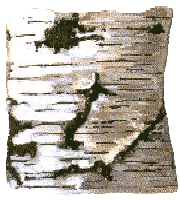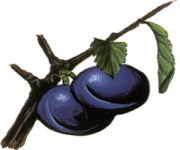
 |
 |
 |
 |
 |
What
Trees might you find in a hedge?
Flowers | Planting | Trees
Trees
What are
trees?
Like all plants, trees need
the correct amount of light space and nutrition to help them grow successfuly.
If you are planting trees, you should check to see
if it prefers a certain kind of soil or other has other natural
preferences.
Alder

The Alder Tree: Above you will see examples of the fruit, leaves and flowers.
The Alder is a native to Ireland and found growing mainly in wet areas along canals, rivers and streams. It is useful for preventing soil erosion with its tightly bound root system. Its wood has many uses including wooden soles, charcoal and tanning.
The wood lasts well in wet conditions and is an ideal tree for planting in urban areas because it grows well on poor and disturbed soils. The roots of the tree contain nodes, inside which lives a bacteria which collects nitrogen from the atmosphere. This process helps to enrich the soil for itself and other plants.
Despite all these benefits Alder is inedible to horses and deer and was once believed to be an ‘unlucky’ tree. Pollination begins by tiny seeds growing in conifer-like cones and then being distributed by wind into water. The dark green round or oval leaves are much loved by a variety of insects. The bark is fissured like the Oak and is home to many invertebrates and species of fungi. Despite this the Alder recovers well from this damage.
Ash - Common
The Ash - Common
One of the most widespread trees in the country, the Ash is at home on most soil, but thrives in moist, lime-rich areas. The name is derived from the Saxon aesc (spear), as the properties of it’s wood are light, tough and flexible. This is reflected in the uses of Ash wood over the years. From sports equipment (hurleys) to ladders, walking sticks to oars, even coaches, cars and aircraft, have been constructed using this wood.
Ash coppices well, producing long, straight poles in a very short time. It is usually the latest tree to come into leaf and casts little shade, supporting rich understory vegetation. The seeds, or keys, are pollinated and distributed by the wind, but it can take several years to germinate. They provide a food source for birds and mammals. The seeds can be pickled and eaten. Identifiable in Winter by opposite black buds on a light green or silver twig, it can reach up to forty metres in height and supports a large variety of insects and lichens.
Ash is associated with healing and is frequently found near ‘holy wells’.
Ash Tree
The Ash Tree
Beech

The Beech Tree:
The Beech is a relative of the Oak tree and not native to Ireland although it may have been in the past as its pollen has been found in bogs. The Beech tree is part of our heritage as it was (re) introduced to Ireland during our estate building era. It is a common domestic plant that provides good screening.
Beech provides fine-grained wood, often found in furniture. It likes acidic soils and is identifiable by its metallic-grey bark. Its buds are pointed and dark brown on zigzag twigs, retaining its leaves winter though they are brown and shrivelled. The Beech tree does not have a good root system and can be susceptible to strong winds, It rarely lives more than 200 years.
The Irish Beech is home to many different types of fungi and has nuts that are edible. Its wood is smooth and is used for furniture and handles.
Birch

The Birch Tree:
Familiar to many, the Silver Birch, is one of two native Birches ino Ireland. It is well adapted to living in exposed areas. With it’s pealing bark, small and colourful leaves, flexible stems and vigorous growth on all soil types, Birches make perfect street and city trees.
Birch wood has been used for many purposes. Toghers ,wooden walkways across bogland, were made from Birch. It is also used for flooring, roofing, furniture, brooms and brewing oil. Birch is now being used as biomass in paper manufacturing. The two Birch species are difficult to tell apart and often hybridise. Catkins and leaves appear at the same time in May, producing vast quantities of tiny seeds.
Identifiable by the grey to silvery-white pealing bark, it supports a large number of insects and colourful fungi.
Blackthorn - Sloe
